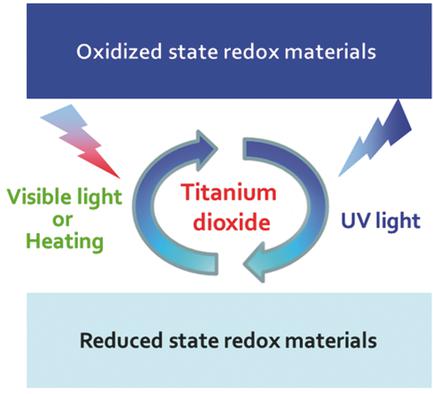当前位置:
X-MOL 学术
›
Small Methods
›
论文详情
Our official English website, www.x-mol.net, welcomes your
feedback! (Note: you will need to create a separate account there.)
Photocatalytic Reversible Color Switching Based on Titania Nanoparticles
Small Methods ( IF 10.7 ) Pub Date : 2017-12-06 , DOI: 10.1002/smtd.201700273 Wenshou Wang 1, 2 , Luntao Liu 1 , Ji Feng 2 , Yadong Yin 2
Small Methods ( IF 10.7 ) Pub Date : 2017-12-06 , DOI: 10.1002/smtd.201700273 Wenshou Wang 1, 2 , Luntao Liu 1 , Ji Feng 2 , Yadong Yin 2
Affiliation

|
The photoreversible color switching system holds great promise for applications in display and signage technologies, sensing devices, and security features, because light, in comparison to other stimuli such as heat and electricity, has the advantages of noninvasiveness and easy control of parameters including wavelength, intensity, coverage area, and illumination duration. Here, the recent advances in the design and synthesis of titania nanoparticles for catalytic photoreversible color switching of redox dyes and pigments, along with their applications in ink‐free, light‐printable rewritable paper and colorimetric oxygen indicators, are reviewed. Specifically, the importance of surface engineering and defect manipulation of titania nanoparticles for the color‐switching purpose, by introducing a number of methods including surface binding of sacrificial capping ligands and creating oxygen vacancies through doping of metal ions, is highlighted. Finally, a summary and perspectives on current challenges and future research directions in this field are given.
中文翻译:

基于二氧化钛纳米粒子的光催化可逆颜色转换
光可逆颜色切换系统在显示和标牌技术,传感设备和安全功能方面具有广阔的应用前景,因为与热和电等其他刺激相比,光具有无创性且易于控制波长,波长等参数的优势。强度,覆盖区域和照明持续时间。在此,对用于氧化还原染料和颜料的光可逆光催化转换的二氧化钛纳米颗粒的设计和合成的最新进展,以及它们在无墨,可光印刷可写纸和比色氧指示剂中的应用进行了综述。具体来说,二氧化钛纳米粒子的表面工程和缺陷处理对于颜色转换的重要性,通过引入许多方法,包括牺牲性封端配体的表面结合和通过掺杂金属离子产生氧空位,被重点介绍。最后,总结并展望了该领域当前的挑战和未来的研究方向。
更新日期:2017-12-06
中文翻译:

基于二氧化钛纳米粒子的光催化可逆颜色转换
光可逆颜色切换系统在显示和标牌技术,传感设备和安全功能方面具有广阔的应用前景,因为与热和电等其他刺激相比,光具有无创性且易于控制波长,波长等参数的优势。强度,覆盖区域和照明持续时间。在此,对用于氧化还原染料和颜料的光可逆光催化转换的二氧化钛纳米颗粒的设计和合成的最新进展,以及它们在无墨,可光印刷可写纸和比色氧指示剂中的应用进行了综述。具体来说,二氧化钛纳米粒子的表面工程和缺陷处理对于颜色转换的重要性,通过引入许多方法,包括牺牲性封端配体的表面结合和通过掺杂金属离子产生氧空位,被重点介绍。最后,总结并展望了该领域当前的挑战和未来的研究方向。











































 京公网安备 11010802027423号
京公网安备 11010802027423号